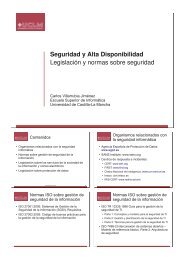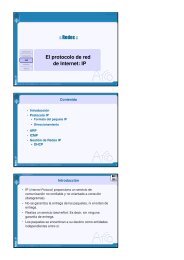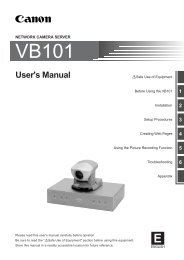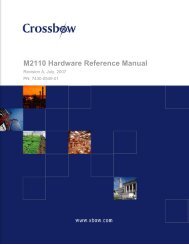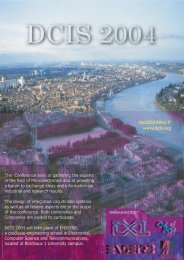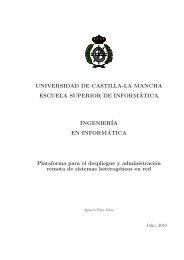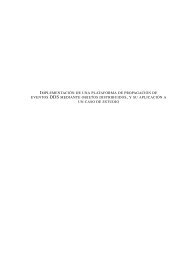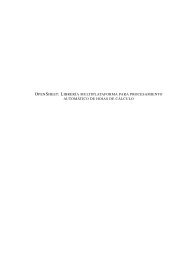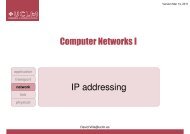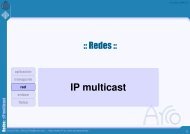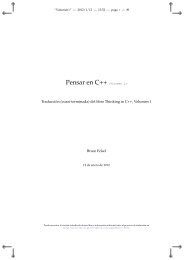Direccionamiento IP :: Redes ::
Direccionamiento IP :: Redes ::
Direccionamiento IP :: Redes ::
Create successful ePaper yourself
Turn your PDF publications into a flip-book with our unique Google optimized e-Paper software.
Versión 28/02/11<br />
:: <strong>Redes</strong> ::<br />
aplicación<br />
transporte<br />
<strong>Redes</strong> : : <strong>Direccionamiento</strong> <strong>IP</strong><br />
red<br />
enlace<br />
física<br />
<strong>Direccionamiento</strong> <strong>IP</strong><br />
David Villa :: http://www.inf-cr.uclm.es/www/dvilla/ 1
Contenidos<br />
<strong>Direccionamiento</strong> con clases<br />
Subnetting<br />
● VLSM<br />
<strong>Redes</strong> : : <strong>Direccionamiento</strong> <strong>IP</strong><br />
Supernetting<br />
<strong>Direccionamiento</strong> sin clases<br />
CIDR<br />
Resumen de rutas (Summarizing)<br />
David Villa :: http://www.inf-cr.uclm.es/www/dvilla/ 2
Dirección <strong>IP</strong><br />
<strong>Redes</strong> : : <strong>Direccionamiento</strong> <strong>IP</strong><br />
La dirección <strong>IP</strong> es un número de 32 bits e identifica el punto de<br />
conexión (la interfaz) entre un host y una red. El espacio de<br />
direccionamiento es 2 32 = 4.294.967.296<br />
Un host con conexiones a varias redes debe tener (al menos) una<br />
dirección <strong>IP</strong> por cada interfaz.<br />
La dirección <strong>IP</strong> tiene dos partes:<br />
●<br />
●<br />
Un NetID, que identifica una red (designado por una autoridad global),<br />
la IANA (Internet Assigned Number Authority)<br />
Un HostID, que identifica un host dentro de esa red.<br />
subred<br />
32 bits<br />
host<br />
David Villa :: http://www.inf-cr.uclm.es/www/dvilla/ 3
Direcciones <strong>IP</strong> especiales<br />
00000000.00000000.00000000.00000000<br />
Este host<br />
11111111.11111111.11111111.11111111 Todos los hosts de esta red<br />
XX ... XX<br />
00 ... 00<br />
Esa red<br />
<strong>Redes</strong> : : <strong>Direccionamiento</strong> <strong>IP</strong><br />
XX ... XX<br />
11 ... 11<br />
Todos los host de esa red<br />
00 ... 00 XX ... XX Un host de esta red<br />
01111111.00000000.00000000.00000001 iface loopback<br />
David Villa :: http://www.inf-cr.uclm.es/www/dvilla/ 4
<strong>Direccionamiento</strong> con clase (classful addressing)<br />
Hay 5 clases, que se reconocen por los bits más significativos:<br />
0<br />
0 1 2 3 4 5 6 7 8 9<br />
1<br />
0 1 2 3 4 5 6 7 8 9<br />
2<br />
0 1 2 3 4 5 6 7 8 9<br />
3<br />
0 1<br />
0 net id<br />
host id<br />
Clase A (2 7 -3 redes)<br />
10 net id<br />
host id Clase B (2 14 -16 redes)<br />
110 net id<br />
host id Clase C (2 21 -256 redes)<br />
<strong>Redes</strong> : : <strong>Direccionamiento</strong> <strong>IP</strong><br />
1110 dirección multicast<br />
Clase D<br />
1111 reservado uso futuro<br />
Clase E<br />
David Villa :: http://www.inf-cr.uclm.es/www/dvilla/ 5
:: <strong>Direccionamiento</strong> ::<br />
<strong>Direccionamiento</strong> con clase (classful addressing)<br />
A: 2 31 direcciones (50%). 1.0.0.0 - 127.255.255.255<br />
B: 2 30 direcciones (25%). 128.0.0.0 - 191.255.255.255<br />
C: 2 29 direcciones (12,5%). 192.0.0.0 - 223.255.255.255<br />
D: 2 28 direcciones (6,25%). 224.0.0.0 - 239.255.255.255<br />
E: 2 28 direcciones (6,25%). 240.0.0.0 - 255.255.255.255<br />
RFC<br />
3330<br />
<strong>Redes</strong> : : <strong>Direccionamiento</strong> <strong>IP</strong><br />
Rangos para direccionamiento privado. Los paquetes cuyo destino sea una<br />
dirección <strong>IP</strong> privada no pueden atravesar ningún enrutador.<br />
RFC<br />
10.0.0.0 - 10.255.255.255/8 (16.777.216 hosts en 1 bloque)<br />
1918<br />
172.16.0.0 - 172.31.255.255/12 (1.048.576 hosts en 16 bloques)<br />
192.168.0.0 - 192.168.255.255/16 (65.536 hosts en 256 bloques)<br />
David Villa :: http://www.inf-cr.uclm.es/www/dvilla/ 6
<strong>Direccionamiento</strong> con clase<br />
direcciones de red (net id)<br />
Las direcciones de red tienen varias propiedades:<br />
●<br />
●<br />
●<br />
Es la primera dirección de cada bloque<br />
Identifica a toda una red desde el punto de vista de internet<br />
Dada una dirección de red se puede averiguar la clase a la<br />
que pertenece, el bloque (net id) y el rango de direcciones en<br />
ese bloque<br />
<strong>Redes</strong> : : <strong>Direccionamiento</strong> <strong>IP</strong><br />
David Villa :: http://www.inf-cr.uclm.es/www/dvilla/ 7
Una máscara es un número de 32 bits tal que al hacer un<br />
AND con una dirección <strong>IP</strong> dada obtenemos la dirección de<br />
red que le corresponde.<br />
es de clase B<br />
<strong>Direccionamiento</strong> con clase<br />
máscara de red<br />
161 67 38 13<br />
1010 0001<br />
0100 0011 0010 0110 0000 1101<br />
<strong>Redes</strong> : : <strong>Direccionamiento</strong> <strong>IP</strong><br />
máscara 1111 1111 1111 1111 0000 0000 0000 0000<br />
dirección de red 1010 0001 0100 0011 0000 0000 0000 0000<br />
David Villa :: http://www.inf-cr.uclm.es/www/dvilla/ 8
<strong>Direccionamiento</strong> con clase<br />
máscara de red<br />
Máscaras por defecto para las tres clases<br />
A<br />
B<br />
C<br />
255 0 0 0<br />
255 255 0 0<br />
255 255 255 0<br />
<strong>Redes</strong> : : <strong>Direccionamiento</strong> <strong>IP</strong><br />
Si se utiliza estrictamente el esquema de direccionamiento<br />
con clases las máscaras no son necesarias.<br />
La máscara 255.255.0.0 se puede indicar también así:<br />
●<br />
161.67.27.38 /16 (Se denomina notación CIDR)<br />
David Villa :: http://www.inf-cr.uclm.es/www/dvilla/ 9
Subnetting<br />
RFC<br />
950<br />
Problema: Las redes de clase A y B están infrautilizadas.<br />
Solución: Se dividen en “sub-redes” más pequeñas. Se utiliza<br />
parte del sufijo (host id) como identificador de la sub-red.<br />
0<br />
0 1 2 3 4 5 6 7 8 9<br />
10 net id<br />
1<br />
0 1 2 3 4 5 6 7 8 9<br />
2<br />
0 1 2 3 4 5 6 7 8 9<br />
host id<br />
3<br />
0 1<br />
RFC<br />
1878<br />
n bits -> 2 n subredes<br />
<strong>Redes</strong> : : <strong>Direccionamiento</strong> <strong>IP</strong><br />
sub-net id<br />
El esquema de la figura utiliza un “sub-net id” de 4 bits, de modo<br />
que se dispone de 16 sub-redes con 2 12 -2 hosts cada una.<br />
El esquema de sub-redes lo decide el administrador de la red.<br />
David Villa :: http://www.inf-cr.uclm.es/www/dvilla/ 10
Subnetting<br />
El número de sub-redes siempre debe ser una potencia de 2.<br />
Se puede aplicar a cualquier bloque (red o subred) que no se esté<br />
utilizando.<br />
Es una decisión del diseño local, es transparente desde Internet.<br />
Ejemplo: Aplicar subnetting a la siguiente red para conseguir 4 bloques<br />
iguales:<br />
141.14.0.1 141.14.0.2 141.14.192.2<br />
141.14.255.253 141.14.255.254<br />
<strong>Redes</strong> : : <strong>Direccionamiento</strong> <strong>IP</strong><br />
Red: 141.14.0.0<br />
Red clase B convencional<br />
141.14.201.4<br />
Internet<br />
David Villa :: http://www.inf-cr.uclm.es/www/dvilla/ 11
Subnetting :: ejemplo (cont)<br />
141.14.0.1 141.14.0.2<br />
141.14.63.254 141.14.64.1 141.14.64.2<br />
141.14.127.254<br />
Sub-red: 141.14.0.0/18<br />
Sub-red: 141.14.64.0/18<br />
X.X.0000 0000.0 X.X.0100 0000.0<br />
141.14.44.12<br />
141.14.88.9<br />
141.14.198.24<br />
141.14.128.1 141.14.128.2<br />
141.14.191.254<br />
141.14.192.1 141.14.192.2<br />
141.14.255.254<br />
<strong>Redes</strong> : : <strong>Direccionamiento</strong> <strong>IP</strong><br />
Sub-red: 141.14.128.0/18<br />
Sub-red: 141.14.192.0/18<br />
X.X.1000 0000.0 X.X.1100 0000.0<br />
Red clase B subdividida<br />
en 4 sub-redes<br />
141.14.167.20<br />
Internet<br />
141.14.201.4<br />
David Villa :: http://www.inf-cr.uclm.es/www/dvilla/ 12
Subnetting<br />
Máscara de la sub-red<br />
Para poder realizar un enrutado efectivo es necesario<br />
definir la máscara de la sub-red.<br />
Para el ejemplo anterior:<br />
0<br />
1<br />
0 1 2 3 4 5 6 7 8 9 0 1 2 3 4 5 6 7 8 9<br />
10 net id<br />
2<br />
0 1 2 3 4 5 6 7 8 9<br />
host id<br />
3<br />
0 1<br />
<strong>Redes</strong> : : <strong>Direccionamiento</strong> <strong>IP</strong><br />
●<br />
sub-net id<br />
La máscara es:<br />
1111 1111 1111 1111 11 00 0000 0000 0000<br />
David Villa :: http://www.inf-cr.uclm.es/www/dvilla/ 13
Cuando se utiliza una máscara de subred de tamaño fijo, todas las<br />
subredes deben tener el mismo tamaño.<br />
Esto supone un gran desperdicio de direcciones cuando se necesitan<br />
bloques pequeños, p.ej. enlaces serie (que sólo necesitan dos<br />
direcciones)<br />
Subnetting<br />
Variable Length Subnet Mask (VLSM)<br />
<strong>Redes</strong> : : <strong>Direccionamiento</strong> <strong>IP</strong><br />
VLSM permite aplicar subnetting de forma anidada.<br />
VLSM requiere soporte de los protocolos de enrutamiento dinámico.<br />
R<strong>IP</strong>v1 y GRP mientras que R<strong>IP</strong>v2, OSPF y EIGRP sí lo soportan<br />
David Villa :: http://www.inf-cr.uclm.es/www/dvilla/ 14
Variable Length Subnet Mask (VLSM)<br />
(Ejemplo 1)<br />
Supongamos que hay que dividir la red de clase C 200.10.10.0<br />
en tres subredes de 120, 60 y 60 hosts.<br />
Subred 0:<br />
● Dirección: 200.10.10.0 /25<br />
<strong>Redes</strong> : : <strong>Direccionamiento</strong> <strong>IP</strong><br />
200.10.10.0/24:<br />
● Permite 126 hosts<br />
200.10.10.0/24:<br />
● Permite 62 hosts<br />
Subred 1:<br />
● Dirección: 200.10.10.128 /26<br />
● Permite 62 hosts<br />
Subred 2:<br />
● Dirección: 200.10.10.192 /26<br />
200.10.10.0/25<br />
200.10.10.128/25<br />
● 200.10.10.128/26<br />
● 200.10.10.192/26<br />
David Villa :: http://www.inf-cr.uclm.es/www/dvilla/ 15
172.16.1.0/24 172.16.2.0/24<br />
Variable Length Subnet Mask (VLSM)<br />
(Ejemplo 2)<br />
Subdividimos la subred 172.16.14.0/24 para conseguir 8 subredes de<br />
distintos tamaños:<br />
172.16.14.0/26<br />
172.16.14.64/26<br />
172.16.14.128/26<br />
172.16.14.192/26<br />
●<br />
172.16.14.192/27<br />
172.16.14.0/26<br />
172.16.14.224/30<br />
●<br />
172.16.14.224/27<br />
•<br />
172.16.14.224/30<br />
172.16.14.64/26<br />
172.16.14.228/30<br />
<strong>Redes</strong> : : <strong>Direccionamiento</strong> <strong>IP</strong><br />
•<br />
172.16.14.228/30<br />
•<br />
172.16.14.232/30<br />
•<br />
172.16.14.236/30<br />
•<br />
172.16.14.240/30<br />
•<br />
172.16.14.244/30<br />
•<br />
172.16.14.248/30<br />
•<br />
172.16.14.252/30<br />
172.16.14.128/26<br />
172.16.14.232/30<br />
172.16.14.192/27<br />
172.16.14.236/30<br />
172.16.14.0/24<br />
David Villa :: http://www.inf-cr.uclm.es/www/dvilla/ 16
Supernetting<br />
RFC<br />
1338<br />
Problema: Nadie quiere las redes de clase C porque son demasiado<br />
pequeñas.<br />
Solución: Se agregan para formar “super-redes” más grandes. Se<br />
utiliza parte del prefijo (net id) para direccionar hosts.<br />
0<br />
0 1 2 3 4 5 6 7 8 9<br />
1<br />
0 1 2 3 4 5 6 7 8 9<br />
2<br />
0 1 2 3 4 5 6 7 8 9<br />
3<br />
0 1<br />
110 net id<br />
host id<br />
<strong>Redes</strong> : : <strong>Direccionamiento</strong> <strong>IP</strong><br />
Requisitos:<br />
● El número de bloques agregados debe ser potencia de 2.<br />
●<br />
●<br />
Los bloques deben tener direccionamiento contiguo.<br />
El tercer byte de la primera dirección debe ser divisible por el nº de<br />
bloques.<br />
David Villa :: http://www.inf-cr.uclm.es/www/dvilla/ 17
Supernetting :: Máscara de la super-red<br />
En este caso también es obligatorio disponer de la máscara<br />
para saber a que rango de bloques afecta la super-red<br />
Máscara de super-red<br />
1111 1111 1111 1111 1111 1 000<br />
0000 0000<br />
Supernetting<br />
- 3 bits<br />
<strong>Redes</strong> : : <strong>Direccionamiento</strong> <strong>IP</strong><br />
Máscara por defecto<br />
para una red clase C<br />
Máscara de sub-red<br />
1111 1111 1111 1111 1111 1111 0000 0000<br />
Subnetting<br />
1111 1111 1111 1111 1111 1111 1110<br />
0000<br />
David Villa :: http://www.inf-cr.uclm.es/www/dvilla/ 18<br />
+ 3 bits
<strong>Direccionamiento</strong> sin clases (classless addressing)<br />
<strong>Redes</strong> : : <strong>Direccionamiento</strong> <strong>IP</strong><br />
El direccionamiento con clases (classfull) es poco flexible.<br />
Classless permite definir bloques de direcciones de cualquier tamaño (que<br />
sea potencia de 2).<br />
La primera dirección debe ser divisible por el número de direcciones en el<br />
bloque.<br />
La primera dirección y la máscara definen cada bloque.<br />
Una organización puede hacer subnetting dentro de su bloque. Sin<br />
embargo no tiene sentido aplicar supernetting con classless addressing.<br />
El direccionamiento sin clases plantea problemas de rutado, que<br />
soluciona el CIDR.<br />
David Villa :: http://www.inf-cr.uclm.es/www/dvilla/ 19
Classless Inter-Domain Routing (CIDR)<br />
RFCs<br />
1518 a<br />
1520<br />
<strong>Redes</strong> : : <strong>Direccionamiento</strong> <strong>IP</strong><br />
CIDR se basa en la definición de prefijos de cualquier tamaño que se<br />
van asignando de forma arbórea, por distintas entidades.<br />
La entidad “asignadora” de primer nivel es IANA. en el segundo nivel<br />
hay 5 RIR (Regional Internet Registry) que a su vez reparten el<br />
espacio de direccionamiento entre otras entidades menores.<br />
CIDR utiliza VLSM para definir subredes de forma arbitraria.<br />
Las subredes se pueden agregar con las reglas habituales para<br />
formar “super-redes”.<br />
Con CIDR, los enrutadores deben cambiar la forma en la que<br />
manejan sus tablas de rutas, puesto que las direcciones destino de<br />
los paquetes no son “auto-contenidas”, como sí ocurría en classfull.<br />
David Villa :: http://www.inf-cr.uclm.es/www/dvilla/ 20
CIDR :: Resumen de rutas<br />
El resumen (o agregación) de rutas permite a los encaminadores CIDR<br />
simplificar sus tablas de rutas.<br />
target mask next hop iface<br />
200.10.8.0 22 200.10.0.2 S1<br />
...<br />
200.10.8.0/24<br />
S1: 200.10.10.1/30<br />
E0<br />
E1<br />
200.10.9.0/24<br />
<strong>Redes</strong> : : <strong>Direccionamiento</strong> <strong>IP</strong><br />
S1: 200.10.10.2/30<br />
target mask next hop iface<br />
200.10.8.0 24 - E0<br />
200.10.9.0 24 - E1<br />
200.10.10. 24 - E2<br />
200.10.11. 0 24 - E3<br />
... 0<br />
200.10.11.0/24<br />
200.10.10.0/24<br />
David Villa :: http://www.inf-cr.uclm.es/www/dvilla/ 21<br />
E3<br />
E2
Referencias<br />
Se recomienda repasar y profundizar el contenido de este tema utilizando (al<br />
menos) la siguiente bibliografía básica:<br />
B.F. Transmisión de datos y redes de comunicaciones, cuarta edición 2007.<br />
● Sección 19.1<br />
A.S. <strong>Redes</strong> de computadores. Pearson Educación, Cuarta edición, 2003.<br />
● Pág 438 - 444<br />
<strong>Redes</strong> : : <strong>Direccionamiento</strong> <strong>IP</strong><br />
Behrouz A. Forouzan. TCP/<strong>IP</strong> Protocol Suite. McGraw-Hill, 2003.<br />
● Capítulo 5 y Sección 6.6<br />
CISCO Systems. Inc. Guía del primer año. CCNA 3 y 4. Cisco Press, 2003.<br />
● Capítulo 2<br />
RFCs citadas a lo largo del tema.<br />
David Villa :: http://www.inf-cr.uclm.es/www/dvilla/ 22



